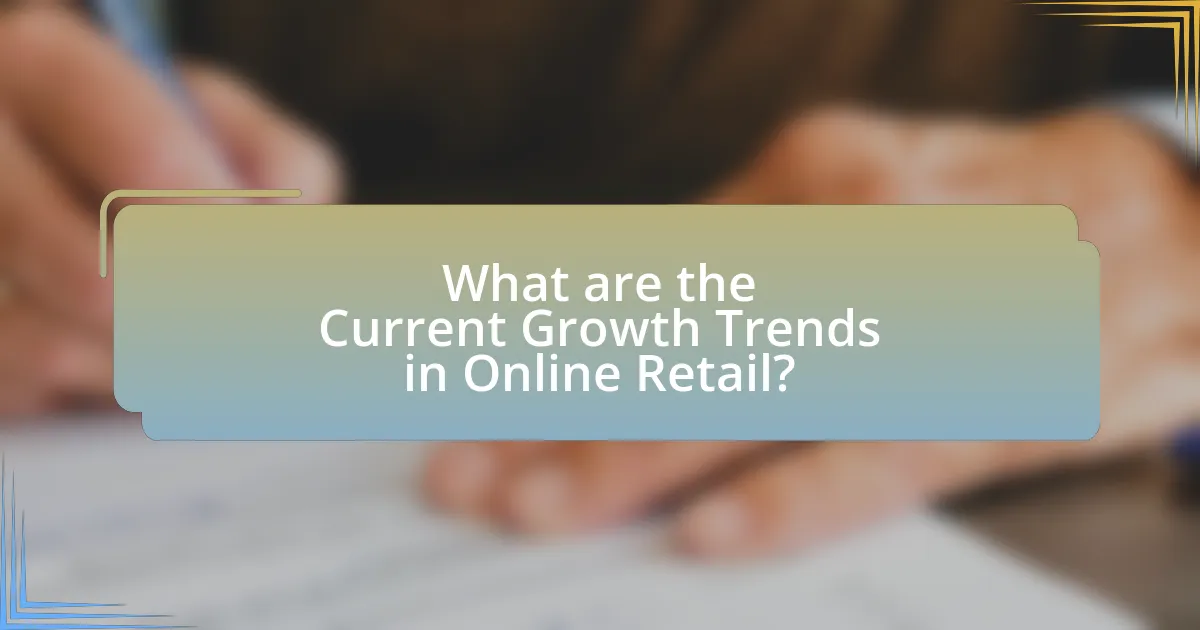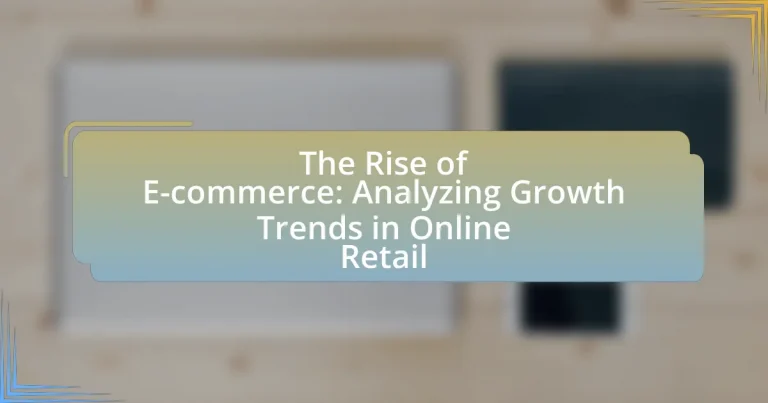E-commerce, defined as the buying and selling of goods and services over the internet, has significantly transformed the retail landscape, reaching global sales of approximately $5.2 trillion in 2022. The article analyzes the evolution of e-commerce from simple online storefronts to complex platforms, highlighting technological advancements such as mobile commerce, artificial intelligence, and secure payment systems that have driven its growth. It also examines changing consumer behaviors, the impact of the COVID-19 pandemic, and the challenges faced by e-commerce businesses, including cybersecurity threats and logistical issues. Key components of e-commerce, various business models, and future growth predictions are discussed, providing a comprehensive overview of current trends and best practices in the online retail sector.

What is E-commerce and Why is it Important?
E-commerce is the buying and selling of goods and services over the internet. It is important because it has transformed the retail landscape, enabling businesses to reach a global audience and consumers to shop conveniently from anywhere. In 2022, global e-commerce sales reached approximately $5.2 trillion, highlighting its significant impact on the economy and consumer behavior. The growth of e-commerce has also led to innovations in logistics, payment systems, and customer service, further enhancing the shopping experience and driving economic growth.
How has E-commerce evolved over the years?
E-commerce has evolved significantly over the years, transitioning from basic online storefronts to complex, multi-channel platforms. Initially, in the 1990s, e-commerce was characterized by simple websites that allowed consumers to purchase products directly, exemplified by the launch of Amazon in 1994 and eBay in 1995. By the early 2000s, the introduction of secure payment systems, such as PayPal in 1998, facilitated consumer trust and increased online transactions.
The 2010s saw the rise of mobile commerce, with smartphones enabling shopping on-the-go, leading to a surge in mobile transactions. According to Statista, mobile e-commerce sales accounted for 72.9% of total e-commerce sales in 2021, highlighting the shift in consumer behavior. Additionally, the integration of social media platforms into e-commerce strategies allowed brands to reach wider audiences and engage customers directly.
In recent years, advancements in technology, such as artificial intelligence and machine learning, have further transformed e-commerce by personalizing shopping experiences and optimizing supply chains. The COVID-19 pandemic accelerated this evolution, with a 44% increase in online shopping in 2020, as reported by Adobe Analytics, underscoring the growing reliance on digital retail channels.
What technological advancements have driven E-commerce growth?
Technological advancements such as mobile commerce, artificial intelligence, cloud computing, and secure payment systems have significantly driven E-commerce growth. Mobile commerce enables consumers to shop via smartphones, leading to a 54% increase in mobile sales from 2019 to 2021, according to Statista. Artificial intelligence enhances customer experiences through personalized recommendations and chatbots, which can increase conversion rates by up to 30%. Cloud computing allows for scalable infrastructure, enabling businesses to handle increased traffic and data storage efficiently. Secure payment systems, including digital wallets and encryption technologies, have built consumer trust, contributing to a 20% rise in online transactions in 2020, as reported by the U.S. Department of Commerce.
How have consumer behaviors changed in relation to E-commerce?
Consumer behaviors have shifted significantly towards E-commerce, with a marked increase in online shopping frequency and preference. According to a 2021 report by McKinsey, 75% of consumers tried new shopping behaviors during the pandemic, with many continuing to shop online even after restrictions eased. This trend is evidenced by a 2022 Statista report indicating that global E-commerce sales reached approximately $5.2 trillion, reflecting a 15% increase from the previous year. Additionally, consumers now prioritize convenience, with 60% of shoppers valuing fast delivery options, as highlighted in a 2023 survey by Deloitte. These changes illustrate a fundamental transformation in how consumers engage with retail, favoring digital platforms over traditional brick-and-mortar stores.
What are the key components of E-commerce?
The key components of E-commerce include online storefronts, payment gateways, logistics and supply chain management, customer relationship management (CRM), and digital marketing. Online storefronts serve as the primary interface for consumers to browse and purchase products, while payment gateways facilitate secure transactions. Logistics and supply chain management ensure timely delivery of products, and CRM systems help businesses manage customer interactions and data. Digital marketing strategies, such as search engine optimization (SEO) and social media marketing, drive traffic to online stores. These components collectively enable businesses to operate efficiently in the online retail space, contributing to the significant growth of E-commerce, which reached over $4.2 trillion in global sales in 2020, according to Statista.
What types of E-commerce models exist?
There are several types of e-commerce models, including Business-to-Consumer (B2C), Business-to-Business (B2B), Consumer-to-Consumer (C2C), Consumer-to-Business (C2B), and Business-to-Government (B2G). B2C involves businesses selling directly to consumers, exemplified by online retailers like Amazon. B2B focuses on transactions between businesses, such as suppliers selling to manufacturers. C2C allows consumers to sell to each other, often facilitated by platforms like eBay. C2B enables consumers to offer products or services to businesses, as seen in freelance marketplaces. B2G involves businesses providing goods or services to government entities, which is common in public procurement. These models reflect the diverse interactions in the e-commerce landscape, driven by technological advancements and changing consumer behaviors.
How do payment gateways facilitate E-commerce transactions?
Payment gateways facilitate E-commerce transactions by acting as intermediaries that securely process payment information between customers and merchants. They encrypt sensitive data, such as credit card numbers, ensuring that this information is transmitted safely over the internet. According to a report by Statista, the global payment gateway market is projected to grow significantly, reflecting the increasing reliance on digital payment solutions in E-commerce. This growth underscores the essential role payment gateways play in enabling seamless and secure online transactions, which is crucial for consumer trust and business success in the digital marketplace.

What are the Current Growth Trends in Online Retail?
Current growth trends in online retail indicate a significant increase in mobile commerce, with mobile sales projected to account for 54% of total e-commerce sales by 2025. Additionally, the rise of social commerce is notable, as platforms like Instagram and Facebook are integrating shopping features, leading to a 25% increase in sales through social media channels in 2022. Subscription services are also gaining traction, with a 15% annual growth rate, reflecting consumer preference for convenience and personalized shopping experiences. These trends are supported by data from eMarketer and Statista, which highlight the ongoing shift towards digital shopping and the increasing importance of mobile and social platforms in driving sales.
How has the COVID-19 pandemic impacted E-commerce growth?
The COVID-19 pandemic has significantly accelerated E-commerce growth, with global online sales increasing by 27.6% in 2020, reaching approximately $4.28 trillion. This surge was driven by lockdown measures and social distancing protocols that forced consumers to shift from physical stores to online shopping. According to a report by eMarketer, U.S. E-commerce sales grew by 32.4% in 2020, marking the highest annual growth rate in over two decades. Additionally, the pandemic led to a rise in new online shoppers, with 10 years’ worth of E-commerce growth occurring in just three months during the initial outbreak. These statistics illustrate the profound and lasting impact of the pandemic on the E-commerce sector.
What shifts in consumer spending patterns have been observed?
Shifts in consumer spending patterns have increasingly favored online retail over traditional brick-and-mortar stores. This trend is evidenced by a significant rise in e-commerce sales, which accounted for 21% of total retail sales in the United States in 2021, up from 15% in 2019, according to the U.S. Census Bureau. Additionally, consumers have shown a preference for convenience and contactless shopping options, leading to increased spending on digital platforms and a decline in foot traffic to physical stores.
How have businesses adapted to the surge in online shopping?
Businesses have adapted to the surge in online shopping by enhancing their digital presence and optimizing logistics. Many companies have invested in e-commerce platforms, improving website functionality and user experience to facilitate seamless transactions. For instance, in 2020, U.S. e-commerce sales grew by 32.4% compared to the previous year, highlighting the necessity for businesses to pivot towards online sales channels. Additionally, firms have implemented advanced inventory management systems and partnered with delivery services to ensure timely fulfillment, responding to the increased demand for home delivery options. This strategic shift has allowed businesses to maintain competitiveness and meet consumer expectations in a rapidly evolving retail landscape.
What role do mobile devices play in E-commerce growth?
Mobile devices are crucial to E-commerce growth as they facilitate convenient shopping experiences, leading to increased consumer engagement and sales. In 2022, mobile commerce accounted for 72.9% of total E-commerce sales, highlighting the significant shift towards mobile platforms. The accessibility of mobile devices allows consumers to shop anytime and anywhere, driving impulse purchases and enhancing overall market reach for retailers. Additionally, mobile apps and optimized websites improve user experience, further contributing to higher conversion rates.
How has mobile commerce changed the shopping experience?
Mobile commerce has transformed the shopping experience by enabling consumers to shop anytime and anywhere through their smartphones. This accessibility has led to a significant increase in impulse purchases, with studies indicating that 79% of smartphone users have made a purchase using their device. Additionally, mobile commerce has facilitated personalized shopping experiences through targeted advertisements and recommendations, enhancing customer engagement. The integration of mobile payment options has streamlined the checkout process, reducing cart abandonment rates, which were reported at 69.57% in 2020. Overall, mobile commerce has made shopping more convenient, efficient, and tailored to individual preferences.
What are the statistics on mobile shopping trends?
Mobile shopping trends indicate that 79% of smartphone users have made a purchase using their device in the past six months. This statistic highlights the growing reliance on mobile platforms for shopping, with mobile commerce accounting for 72.9% of total e-commerce sales in 2021, a figure projected to reach 77% by 2025. Additionally, 54% of consumers prefer shopping on mobile apps over websites, emphasizing the importance of app optimization for retailers. These statistics underscore the significant shift towards mobile shopping, driven by convenience and accessibility.

What Challenges Does E-commerce Face?
E-commerce faces several significant challenges, including cybersecurity threats, high competition, and logistical issues. Cybersecurity threats, such as data breaches and fraud, pose risks to both businesses and consumers, with a report from Cybersecurity Ventures predicting that cybercrime will cost the world $10.5 trillion annually by 2025. High competition in the online marketplace leads to price wars and reduced profit margins, as evidenced by the rapid growth of platforms like Amazon, which dominates with a market share of over 38% in the U.S. e-commerce sector. Logistical issues, including shipping delays and inventory management, can hinder customer satisfaction and operational efficiency, with a survey by the National Retail Federation indicating that 75% of consumers expect same-day delivery, putting pressure on e-commerce businesses to meet these demands.
What are the security concerns associated with online retail?
The security concerns associated with online retail include data breaches, payment fraud, and identity theft. Data breaches occur when unauthorized individuals access sensitive customer information, which can lead to significant financial losses and reputational damage for retailers. According to a report by IBM, the average cost of a data breach in 2021 was $4.24 million. Payment fraud involves the unauthorized use of credit card information, which can result in chargebacks and loss of revenue for businesses. Additionally, identity theft can occur when personal information is stolen and used to create fraudulent accounts, impacting both consumers and retailers. These concerns highlight the need for robust security measures in the online retail sector.
How can businesses protect customer data in E-commerce?
Businesses can protect customer data in E-commerce by implementing robust cybersecurity measures, including encryption, secure payment gateways, and regular security audits. Encryption ensures that sensitive information, such as credit card details and personal data, is converted into a secure format that is unreadable to unauthorized users. Secure payment gateways, such as those compliant with Payment Card Industry Data Security Standards (PCI DSS), provide an additional layer of protection during transactions. Regular security audits help identify vulnerabilities in the system, allowing businesses to address potential threats proactively. According to a 2021 report by Cybersecurity Ventures, cybercrime is projected to cost the world $10.5 trillion annually by 2025, highlighting the critical need for effective data protection strategies in E-commerce.
What are the implications of data breaches for E-commerce companies?
Data breaches have severe implications for e-commerce companies, including financial losses, reputational damage, and legal consequences. Financially, companies can face costs exceeding $3.86 million per breach, as reported by the Ponemon Institute in 2020. Reputationally, 60% of consumers may stop purchasing from a brand after a data breach, according to a study by KPMG. Legally, e-commerce companies may incur penalties and lawsuits due to non-compliance with data protection regulations like GDPR, which can result in fines up to 4% of annual global revenue. These factors collectively threaten the sustainability and growth of e-commerce businesses.
How do logistics and supply chain issues affect E-commerce?
Logistics and supply chain issues significantly disrupt E-commerce by causing delays in product delivery, increasing operational costs, and reducing customer satisfaction. For instance, a 2021 survey by the National Retail Federation found that 75% of retailers experienced supply chain disruptions, leading to longer shipping times and inventory shortages. These delays can result in lost sales opportunities, as consumers increasingly expect fast and reliable delivery options. Furthermore, rising shipping costs due to supply chain inefficiencies can erode profit margins for E-commerce businesses, making it essential for them to optimize their logistics strategies to remain competitive in the growing online retail market.
What are the common logistical challenges faced by online retailers?
Online retailers commonly face logistical challenges such as inventory management, shipping delays, and returns processing. Inventory management issues arise from the need to balance stock levels with demand fluctuations, which can lead to overstocking or stockouts. Shipping delays often occur due to factors like carrier capacity constraints and unexpected weather conditions, impacting delivery times and customer satisfaction. Additionally, returns processing can be complex and costly, as it involves restocking items, managing reverse logistics, and handling customer service inquiries. These challenges are critical for online retailers to address in order to maintain operational efficiency and customer loyalty.
How can E-commerce businesses optimize their supply chains?
E-commerce businesses can optimize their supply chains by implementing advanced inventory management systems and leveraging data analytics. Advanced inventory management systems, such as just-in-time (JIT) inventory, reduce excess stock and minimize holding costs, leading to more efficient operations. Data analytics enables businesses to forecast demand accurately, allowing for better alignment of supply with customer needs. According to a report by McKinsey, companies that utilize data-driven supply chain strategies can reduce logistics costs by 15% and improve service levels by 20%. This demonstrates that optimizing supply chains through technology and data can significantly enhance operational efficiency and customer satisfaction.
What are the future predictions for E-commerce growth?
Future predictions for e-commerce growth indicate a significant increase, with estimates suggesting that global e-commerce sales will reach approximately $6.4 trillion by 2024, up from $4.9 trillion in 2021. This growth is driven by factors such as the increasing adoption of mobile shopping, advancements in technology, and the expansion of internet access worldwide. According to a report by Statista, e-commerce is expected to account for 21.8% of total global retail sales by 2024, highlighting a robust trend towards online shopping.
How will emerging technologies shape the future of online retail?
Emerging technologies will significantly shape the future of online retail by enhancing customer experiences, streamlining operations, and enabling personalized marketing. Technologies such as artificial intelligence (AI) and machine learning will allow retailers to analyze consumer behavior, predict trends, and tailor recommendations, leading to increased sales. For instance, a report by McKinsey & Company indicates that AI-driven personalization can boost sales by 10% to 30%. Additionally, advancements in augmented reality (AR) will enable customers to visualize products in their own environments before purchasing, improving decision-making and reducing return rates. Furthermore, blockchain technology will enhance supply chain transparency and security, fostering consumer trust. According to a study by Deloitte, 40% of consumers are more likely to purchase from brands that provide transparent supply chain information. These technologies collectively will transform online retail into a more efficient, engaging, and trustworthy shopping experience.
What trends should businesses watch for in the coming years?
Businesses should watch for the continued growth of e-commerce, driven by increasing consumer preference for online shopping. According to a report by eMarketer, global e-commerce sales are projected to reach $6.4 trillion by 2024, reflecting a compound annual growth rate of 16.8% from 2021. Additionally, trends such as the rise of mobile commerce, personalized shopping experiences through AI, and the integration of social commerce platforms are expected to shape the online retail landscape significantly. These trends indicate a shift in consumer behavior and technological advancements that businesses must adapt to in order to remain competitive.
What Best Practices Can E-commerce Businesses Implement?
E-commerce businesses can implement best practices such as optimizing website performance, enhancing user experience, and utilizing data analytics for informed decision-making. Optimizing website performance involves ensuring fast loading times and mobile responsiveness, which studies show can increase conversion rates by up to 70%. Enhancing user experience includes simplifying navigation and providing clear product information, as 88% of online consumers are less likely to return to a site after a bad experience. Utilizing data analytics allows businesses to track customer behavior and preferences, enabling personalized marketing strategies that can boost sales by 20%. These practices are essential for maintaining competitiveness in the rapidly growing e-commerce sector.
How can E-commerce sites enhance user experience?
E-commerce sites can enhance user experience by implementing personalized recommendations based on user behavior and preferences. Research indicates that personalized experiences can increase conversion rates by up to 10%, as users are more likely to engage with content that aligns with their interests. Additionally, optimizing website speed and ensuring mobile responsiveness are crucial, as studies show that a one-second delay in page load time can lead to a 7% reduction in conversions. Furthermore, providing clear navigation and a streamlined checkout process can significantly reduce cart abandonment rates, which average around 70% across various industries. By focusing on these strategies, e-commerce sites can create a more engaging and efficient shopping experience for users.
What strategies can improve customer retention in online retail?
Implementing personalized marketing strategies significantly improves customer retention in online retail. Personalization, such as tailored recommendations based on previous purchases, increases customer engagement and loyalty. According to a study by Epsilon, 80% of consumers are more likely to make a purchase when brands offer personalized experiences. Additionally, enhancing customer service through multiple channels, including live chat and social media, fosters trust and satisfaction, leading to repeat purchases. Research from Zendesk indicates that 87% of customers believe that brands need to put more effort into providing a consistent experience. Loyalty programs that reward repeat purchases also effectively encourage retention; a report by Accenture found that 77% of consumers are more likely to stay loyal to a brand that offers rewards.





